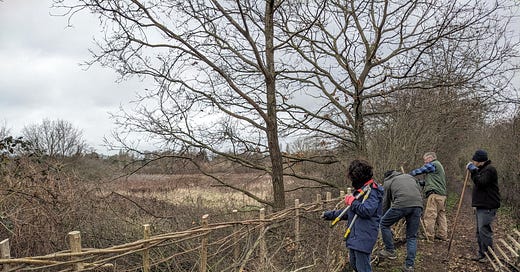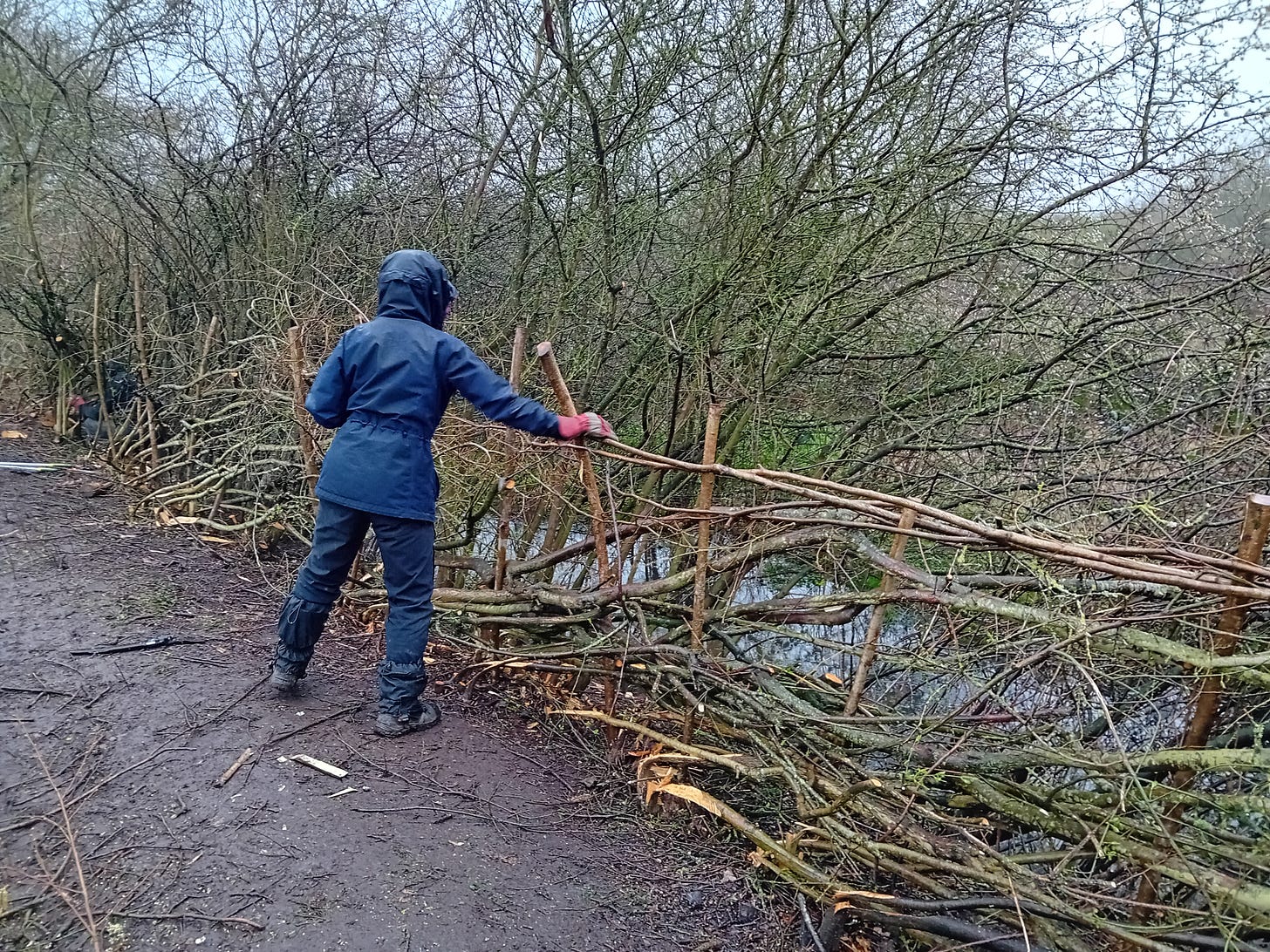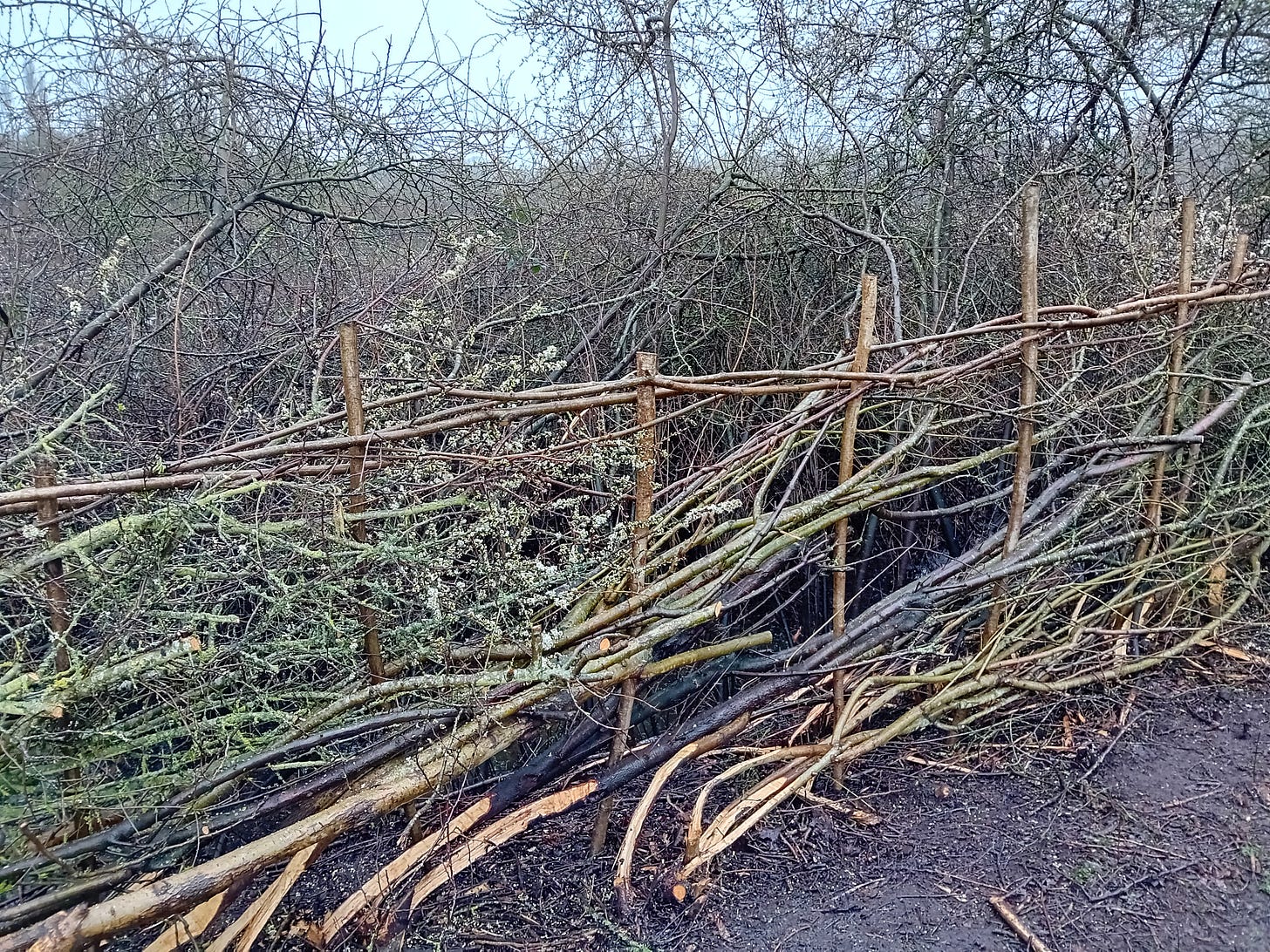One of the places I volunteer regularly with TCV Croydon is South Norwood Country Park where we’ve undertaken a range of tasks over the years - everything from coppicing willow around the lake and planting trees to path maintenance and building lots and lots of dead hedges. In the last couple of years, we’ve also turned our attention to the living hedges here which meant that last winter I had my first opportunity to do some hedge-laying in London. Last week we were back there again to lay a different section of hedge.
Like many traditional skills, hedge-laying is a combination of art, science and sheer hard graft. The physically demanding bit is partly because before you can even begin laying you have to clear out all the bits of the existing hedge that are either dead or too big, too small, too awkward, or just not in quite the right place. As the hedge we were laying was mainly Hawthorn with some Blackthorn behind it, untangling and removing the unwanted bits sometimes involved having to scramble around inside the hedge itself and this part took a fair bit of time. Fortunately, we had a hedge-laying expert on hand to advise us on which stems to get rid of and which to keep for laying, the latter are sometimes known as pleachers.
The science bit comes from the fact that you must always lay a hedge uphill. Sap rises so if the pleachers are laid with their tops facing downhill, they are unlikely to survive, and certainly won’t put on new growth which is the main reason for laying a hedge. The pleaching itself involves using a billhook to make angled cuts into the stem without cutting all the way through, the aim being to get to a point where the remaining stem is thin enough to split all the way down to the ground creating a hinge which allows it to bend without breaking. There’s more science, I’m sure, in identifying the right thickness to aim for – sometimes referred to as “the bark and a little bit of wood” - but when that split happens, especially when it happens easily as it sometimes does on thinner stems, it feels like magic. On thicker stems, getting to “the bark and a little bit of wood” sometimes involves lots more hard work, hacking away with the billhook, but when you do get to the right point the satisfaction is even greater. Then all that remains is to weave the bent-over pleacher into the line of the hedge and tidy up the outside of the hinge by removing the heel of wood left behind.
We finished off by hammering in stakes along the line of the hedge and weaving some of the pleachers around these as well as around each other and then plaiting hazel binders between the stakes and pushing these down firmly to keep the pleachers in place. This is where the art comes in for a well-laid hedge truly is a thing of beauty. And best of all the hazel binders we were using were ones we had coppiced in Happy Valley so the whole hedge was created with items we had produced with our own hands. The finished hedge looked fabulous, and it was also great to have another chance to see the section we laid last winter. The bright pops of green where fresh hawthorn leaves were just emerging on last year’s hedge certainly brightened up a dull wet day.
Traditionally hedge-laying was carried out for practical purposes as much as aesthetic ones. Left unlaid, hedges grow tall and leggy, and gaps form around the base of the trees where there’s too little light for new growth to establish. Eventually these gaps will become big enough for sheep and other small livestock to get through making the hedges useless as barriers. In the days before the ubiquitous barded wire fences that now dominate the countryside, farmers relied on hedges to protect their crops and retain their livestock and for centuries ensuring these hedges were properly maintained was a vital part of rural life in many parts of Britain.
The twentieth century wasn’t kind to hedges. Labour shortages, increased mechanisation and the agricultural subsidies which incentivised mass production in larger fields led to tens of thousands of miles of hedgerows being pulled up. It’s estimated half of Britain’s hedgerows were lost between the 1940s and 1990s. Many of the hedges that remain are no longer laid but instead are cut by machine every year or so, in a process that could be described as “hedge-slaying” as opposed to hedge-laying. I always find it terribly sad to see the awkwardly split branches and battered, hacked-about stems of a hedge that’s been recently machine-cut. Such hedges have often long since ceased to function as a barrier so usually have an ugly barbed wire fence next to them too.
Hedgerows are not only a key part of the character of the countryside, but they are also vital for wildlife. A mixed-species hedge provides nesting habitat for over 30 species of British birds as well as nectar for bees, butterflies and other pollinators and berries and seeds which support numerous insects and small mammals. Hedges provide important wildlife corridors too, allowing smaller creatures to move safely through the landscape. And they can also help us tackle the climate crisis as hedges can store vast amounts of carbon in their roots and leaves and in the soil beneath them.
Little wonder then the Government’s Environmental Improvement Plan includes targets for increasing the amount of hedgerows including supporting farmers to create or restore 30,000 miles of hedgerows a year by 2037. There must be huge potential for having many more miles of hedges in urban areas too. Just imagine if all the fencing around school playgrounds and parks in London were replaced by species-rich hedgerows, how wonderful that would be for wildlife and how amazing the city would look when the Hawthorns and other trees blossom each Spring.
To finish….
…a few things I’d like to share:
BFI short film about hedging: If you want to see hedge-laying made to look easy and explained far better than I can do it, then I highly recommend this film made by the Ministry of Agriculture in 1942 and featuring a land girl and a pipe-smoking hedge-layer extraordinaire.
National Hedge-laying Society (NHLS): The NHLS is a charity dedicated to maintaining hedge-laying skills and supporting the sympathetic management of hedgerows. The NHLS organises a national hedge-laying competition each year and their website is a wealth of information about hedge-laying. I love the fact that slightly different hedge-laying styles developed in different places to take account of differences in the climate and the type of trees available. There are are at least 30 styles in the UK alone, some of which are shown on the website.







This was fascinating. Sad this practice didn’t really make it over to the US with the British settlers — our country roads are endless miles of barbed wire, and I’ve mostly only seen hedges in higher-end housing developments.
Love the idea of installing them around schools. Like her outfit in the film 😁